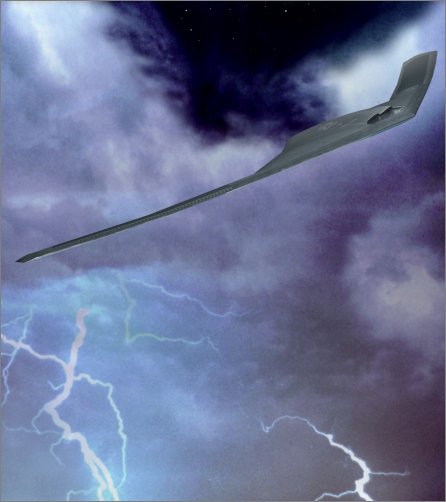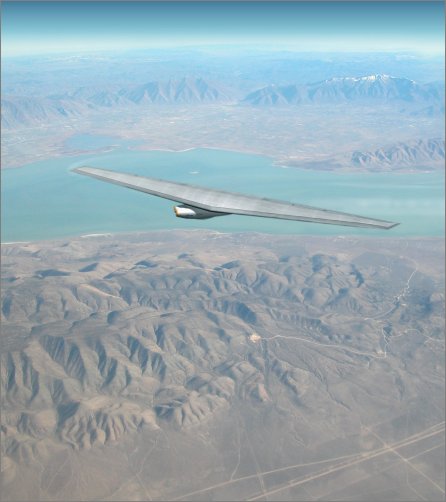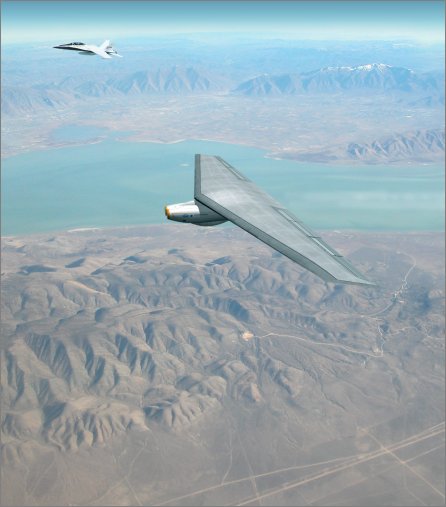Can Northrop build an oblique flying wing X-plane and revolutionise the design of long-range strike aircraft? DARPA has given it a chance to find out
An aircraft that can loiter like a Global Hawk, fly as far as a B-2 and dash like an F-14 would seem a natural fit for a company that has experience with unmanned aircraft, stealthy bombers and supersonic fighters. Now Northrop Grumman has an opportunity to bring all three together in one airframe.
Under a $10.3 million Defense Advanced Research Projects Agency (DARPA) contract, the company is designing a supersonic, tailless, variable-sweep oblique flying wing – attributes that have never been combined in a single airframe before, but which promise an unprecedented blend of long endurance and range and rapid deployment.
There is no guarantee it can be made to work, but if Northrop can successfully fly an oblique flying wing (OFW) X-plane demonstrator as planned around 2010-11, it will give designers a new configuration option for future long-range reconnaissance/strike aircraft.
Unswept at low speed and swept at high speed (centre), the oblique flying wing bridges the gap between efficient loitering (top) and supersonic attack (bottom) designs in one airframe
 |
 |
|
 |
“The planform allows the combination of very efficient low-speed and very efficient supersonic performance, when you want an aircraft that can rapidly redeploy or reposition, but also has efficient take-off, landing, climb, subsonic cruise and loiter,” says DARPA OFW programme manager Thomas Beutner. “This planform allows both.”
The concept has been around almost as long as the swept wing, and designers have been drawn repeatedly to its compelling efficiency and simplicity, but always have shied away from using the oblique wing because of its aerodynamic and control issues. DARPA plans to tackle the most challenging of these with the X-plane demonstrator, so that the OFW can be considered for future military aircraft.
“These are ‘DARPA-hard’ challenges,” says Beutner, using the agency’s favourite phrase. “The supersonic oblique flying wing and tailless variable-sweep flying wing are both extremely challenging, and have never been demonstrated.” Previous flight tests have all been subsonic and have involved aircraft with tails, and in some cases fuselages.
Not all the challenges associated with designing an OFW will be tackled by the planned X-plane programme. “In the tradition of the X-1 and X-29 this is truly a technology demonstrator, and not a prototype,” says Beutner. “It is not a full-scale aircraft, and there is no mission in mind.” The programme will focus on the most challenging aerodynamic and control problems, with the goal of proving that an OFW is feasible.
It is half a century since US aerodynamicist R T Jones suggested that asymmetrically swept, or oblique, wings offered advantages at transonic and supersonic speeds. Jones developed the theory behind high-speed swept wings and calculated that an oblique flying wing offered the lowest supersonic drag. Meanwhile, the practical advantages had been recognised by Germany’s Blohm und Voss, which used a pivoting oblique wing in a 1940s fighter design to produce a simpler and lighter variable-sweep aircraft.
After a promising start, the idea languished, being picked up several times only to be put down again. NASA flew the AD-1 subsonic oblique-wing demonstrator 79 times between 1979 and 1982, but plans for a supersonic demonstrator never materialised. The small, single-seat AD-1 had a wing mounted on the fuselage that could pivot from zero to 60° sweep in flight. In the early 1990s, NASA and Stanford University flew small low-speed models of an oblique flying-wing supersonic transport, but the concept was again dropped.
The idea has never died because it offers a compelling combination of endurance, range and speed in a single aircraft. “OFW has been recognised for decades for its aerodynamic potential. What has been in question is whether it is feasible,” says Beutner. “DARPA’s programme will try to prove out the feasibility and open up the design space. To do that we have to address a combination of issues never before demonstrated in flight.”
Combining good low-speed and high-speed performance in a single aircraft is a difficult task. At low speed, designs tend to be dominated by drag due to lift, which can account for 40% of total drag. Long, slender wings with high aspect ratio generate the lowest lift-induced drag and are used in long-endurance designs like the Global Hawk.
At high speed, meanwhile, designs are dominated by supersonic wave drag, which can account for around 50% of the total. Wave drag is determined by aircraft length and maximum cross-sectional area, and long, slender designs with high fineness ratio like the Concorde generate the lowest supersonic drag. Whereas conventional high-speed aircraft require area ruling, hence the classic “Coke bottle” fuselage of Northrop’s F-5, the OFW’s natural area distribution is close to the ideal for minimum wave drag.
The oblique wing has several advantages over the swept or delta wings normally used in supersonic designs, Beutner explains. For the same sweep, span and area, an asymmetrically swept wing has twice the length of a symmetrically swept wing, and therefore a higher fineness ratio and lower wave drag. And an oblique wing, even when it is swept, has a higher aspect ratio than a delta wing, and therefore lower induced drag.
Varying the sweep of an all-wing aircraft with speed ensures its leading edge is always inside the Mach cone – the bow shock created as it flies supersonically. In line with Jones’s swept wing theory, this ensures the airflow at right angles to the leading edge stays below Mach 1 and avoids the compressibility effects that increase drag.
Variable sweep allows an aircraft to optimise its aspect ratio and fineness ratio and minimise total drag at any Mach number, but conventional, symmetric variable-geometry wings have structural weight penalties because of the heavy pivots that must carry the bending loads from the outer wing panels. While a pivoting oblique wing is simpler and lighter, an oblique flying wing is more aerodynamically and structurally efficient. “It has the structural efficiency of a span-loaded wing, with no breaks or pivots,” says Beutner.
“At high speed, in swept mode, the OFW has a very good area distribution and fineness ratio. At low speed, unswept, it is a high aspect-ratio wing with low drag due to lift,” says Beutner. While a conventional variable-sweep wing is able to optimise loiter and range performance over a broad speed range, the OFW should do better. “It is the limiting case for variable sweep – the entire aircraft sweeps,” he says.
Achieving these advantages will not be easy – everything about an oblique flying wing is asymmetric: aerodynamics, aeroelastics and control. “Controllability is a challenge,” says Beutner. “The moment arms are short, and there are not many control surfaces. If we remove the tail controllability becomes harder. This has been the major stumbling block to proving the feasibility of OFW in the past.”
Almost all the control surfaces are coupled. “It is difficult to develop a moment about one axis. Control is highly coupled and highly non-linear,” says Beutner. “Move the flaps and you get roll, pitch and yaw from a single surface, whereas you can get pure pitch from the horizontal tail on a conventional aircraft.” Add to this the fact that the OFW is expected to be statically and dynamically unstable and the control challenges become clear.
“Variable sweep, tailless control, supersonic asymmetric flying wing – these are enormous challenges,” says Beutner. “We need to have an X-plane demonstrator, experimental only, to prove that the controllability issues can be addressed. To convince ourselves and the design community that OFW is feasible really requires a flight demonstration. This is a difficult case to make by analysis.”
In scope, the unmanned X-plane programme will focus on aerodynamics, aeroelasticity and controllability, and will not look at the design integration issues of a full-size operational vehicle. These include propulsion integration. Where an operational OFW would have embedded propulsion, the X-plane will use pod-mounted pivoting engines. And issues such as where to locate the landing gear and how to integrate a payload into an operational vehicle will only be addressed at a conceptual design level.
The current 20-month Phase 1 will take the X-plane to a preliminary design review, Northrop conducting computational fluid-dynamics analysis and windtunnel testing to mature the technology and reduce risk. Low-speed and high-speed tunnel tests are planned using models of increasing scale and fidelity, says Beutner. Northrop will also develop a “N degree-of- freedom” flight control simulation that adds the vehicle’s aeroelastic modes to the normal rigid-body “6 degree-of-freedom” simulation.
If the OFW programme makes it past a go/no-go decision at the end of Phase 1, Northrop will build and test the X-plane demonstrator in Phase 2. “Until we do this, the oblique flying wing will always be out there with tantalising aerodynamic performance, but without feasibility,” says Beutner. “OFW will not enter the design space until we have proved it can be controlled. And that needs a flight demonstration.”
GRAHAM WARWICK / WASHINGTON DC
All images NORTHROP GRUMMANN
Source: Flight International



























